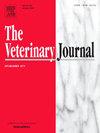Bayesian latent class analyses show that serological testing outperforms conventional diagnostic methods for the detection of Ascaris in (individual) pigs
IF 3.1
2区 农林科学
Q1 VETERINARY SCIENCES
引用次数: 0
Abstract
This study employed Bayesian latent class analyses to estimate the diagnostic accuracy of faecal egg count (FEC), milk spot detection and the ELISA for detection of Ascaris suum using matched samples from individual pigs in Australia. A total of 251 blood, faecal and liver samples were collected from finisher pigs from four Victorian pig farms. Matched samples (n = 189) were used to compare the three diagnostic tests. The ELISA detected a higher proportion of positive samples (56 %; 95 % CI 48–62 %) compared to milk spot detection (42 %; 95 % CI 35–49 %) and FEC (17 %; 95 % CI 12–23 %). Only the ELISA detected A. suum infections on two of the four farms, with 14 % and 41 % within-farm prevalence estimates. Agreement between diagnostic tests was moderate for FEC and milk spot detection (Cohen’s kappa 0.42; 95 % CI 0.30–0.53) and ELISA and milk spot detection (0.52; 0.41–0.64), while fair agreement was observed between FEC and ELISA (0.28; 0.19–0.37). Our latent class analyses identified a higher diagnostic sensitivity for the ELISA (0.92; 95 % CrI [credible interval] 0.86–0.96) than FEC (0.43; 0.34–0.53) and milk spot detection (0.86; 0.79–0.92). A strong association was observed between ELISA outcomes (optical density [OD] and OD ratio [ODr]) and milk spot grades (low, medium, high), with higher OD and ODr values corresponding to an increased number of milk spots on the liver. This study highlights the limitations of conventional A. suum detection methods. Quantitative estimates of the diagnostic sensitivity of the ELISA facilitate its use as a tool for assessing A. suum exposure in pig herds.
贝叶斯潜类分析表明,血清学检测优于(个体)猪蛔虫检测的常规诊断方法。
本研究采用贝叶斯潜类分析来估计粪卵计数(FEC)、奶斑检测和ELISA检测猪蛔虫的诊断准确性,使用澳大利亚个体猪的匹配样本。研究人员从维多利亚四个养猪场的育肥猪身上采集了251头血液、粪便和肝脏样本。配对样本(n = 189)用于比较三种诊断试验。ELISA检测出较高比例的阳性样品(56%;95%置信区间为48%至62%),而牛奶斑点检测(42%;95% CI 35% - 49%)和FEC (17%;95%可信区间12% - 23%)。只有ELISA在四个农场中的两个农场检测到猪单胞菌感染,农场内流行率估计为14%和41%。FEC诊断试验与乳斑检测的一致性中等(Cohen’s kappa 0.42;95% CI 0.30 ~ 0.53), ELISA和乳斑检测(0.52;0.41 ~ 0.64),而FEC和ELISA之间的结果基本一致(0.28;0.19至0.37)。我们的潜在分类分析发现ELISA具有更高的诊断敏感性(0.92;95% CrI[可信区间]0.86 ~ 0.96)高于FEC (0.43;0.34 ~ 0.53),奶斑检测(0.86;0.79 ~ 0.92)。ELISA结果(光密度[OD]和光密度比[ODr])与乳斑分级(低、中、高)之间存在密切关联,肝上乳斑数量越多,OD和ODr值越高。本研究强调了传统的苏氏单胞菌检测方法的局限性。ELISA诊断敏感性的定量估计有助于其作为评估猪群中猪单胞杆菌暴露的工具。
本文章由计算机程序翻译,如有差异,请以英文原文为准。
求助全文
约1分钟内获得全文
求助全文
来源期刊

Veterinary journal
农林科学-兽医学
CiteScore
4.10
自引率
4.50%
发文量
79
审稿时长
40 days
期刊介绍:
The Veterinary Journal (established 1875) publishes worldwide contributions on all aspects of veterinary science and its related subjects. It provides regular book reviews and a short communications section. The journal regularly commissions topical reviews and commentaries on features of major importance. Research areas include infectious diseases, applied biochemistry, parasitology, endocrinology, microbiology, immunology, pathology, pharmacology, physiology, molecular biology, immunogenetics, surgery, ophthalmology, dermatology and oncology.
 求助内容:
求助内容: 应助结果提醒方式:
应助结果提醒方式:


